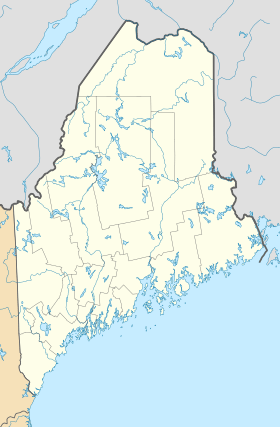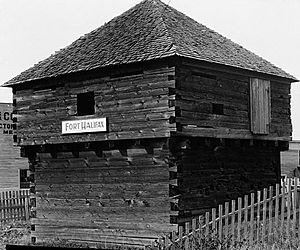Fort Halifax (Maine) facts for kids
|
Fort Halifax
|
|

Fort Halifax
|
|
| Location | On U.S. 201 west of Winslow, Winslow, Maine |
|---|---|
| Built | 1754-1755 |
| NRHP reference No. | 68000015 |
Quick facts for kids Significant dates |
|
| Added to NRHP | November 24, 1968 |
| Designated NHL | October 18, 1968 |
Fort Halifax is an old British fort located in Winslow, Maine. It sits where the Sebasticook River meets the Kennebec River. The fort was first built in 1754 during the French and Indian War. It was made of strong wooden walls.
Today, only one building from the fort, called a blockhouse, is still standing. This blockhouse is the oldest one in the United States. It is now part of the Fort Halifax State Historic Site and is open to visitors in warmer months. The fort helped protect important Native American canoe routes. These routes connected to the St. Lawrence and Penobscot Valleys. In 1968, the blockhouse became a National Historic Landmark.
Contents
Fort Halifax and the French and Indian War
Fort Halifax was built on the north bank of the Sebasticook River. Before this, a Native American fort called Fort Taconnet was in the same spot. That fort was burned by natives during King William's War.
The blockhouse at Fort Halifax is the oldest in the United States. It was part of a group of forts built by the Province of Massachusetts Bay between 1754 and 1756. This was at the start of the French and Indian War.
Why the Fort Was Built
On July 25, 1754, Major General John Winslow arrived with 600 soldiers. Their job was to build the fort where the Kennebec and Sebasticook Rivers meet. William Shirley, a leader from Massachusetts, was also on this trip.
The fort's strong wooden walls were meant to stop French Canadians and their Native American allies. These groups often used the Kennebec River valley to attack English settlements. Massachusetts was also trying to expand its land into an area called Acadia. This expansion threatened Quebec City, the capital of Canada.
Other Nearby Forts
In 1755, Fort Richmond was taken apart. This happened as Fort Shirley (also called Frankfort) and Fort Western were built further upriver. Fort Shirley was named after William Shirley.
The Massachusetts General Court ordered Fort Halifax to be built in 1754. It was placed on the land where the Sebasticook and Kennebec rivers join. The fort was named after George Montagu-Dunk, 2nd Earl of Halifax. He was an important British colonial leader. A town later grew around the fort for protection. It was named Winslow after Major General John Winslow.
Early Attacks and Changes
Native Americans attacked the fort in the fall of 1754. In 1755, Captain William Lithgow was in charge. He changed the original plan for the fort. He said there were not enough soldiers and it cost too much. The fort was made smaller and easier to defend. It was finished in 1756.
French Canadians and Native Americans quickly planned to destroy the fort. In May 1756, Native Americans attacked soldiers from the fort. Later that year, Colonel Lithgow and eight men were ambushed by 17 Native Americans. Both sides lost two men. The fort was left empty in 1766 and later sold to private owners.
Fort Halifax During the American Revolution
In September 1775, Fort Halifax hosted soldiers led by Colonel Benedict Arnold. They were on their way to Quebec City during the American Revolution. After the war ended, most of Fort Halifax was taken apart.
By the early 1800s, only the blockhouse on the Sebasticook River was left. Later in the 1800s, tourists and students from Colby College visited the fort. They sometimes carved pieces of wood from the blockhouse as souvenirs.
Fort Halifax in the 19th and 20th Centuries
The ownership of the Fort Halifax blockhouse changed many times over the years. The fort's buildings fell apart. Eventually, everything except the blockhouse was torn down. From 1924 to 1966, a group called the Fort Halifax Chapter of the Daughters of the American Revolution owned the blockhouse. They were in charge of keeping it in good shape.
In 1966, the Daughters of the American Revolution gave the property to the state. The town of Winslow bought the land around the blockhouse in 1976 and 1982. Their plan was to fix up the area and create a park.
Rebuilding After a Flood
On April 1, 1987, a big flood washed away the blockhouse. Workers found 22 of the original logs. Some of them were found as far as 40 miles away. The blockhouse was rebuilt on its original spot in 1988. That fall, hundreds of people came to a special ceremony to celebrate the rebuilt blockhouse.
In 2011, the Town of Winslow made plans to rebuild some parts of the fort. They also planned to add more signs and displays for visitors. They wanted to improve walking trails and other fun activities at the site.





